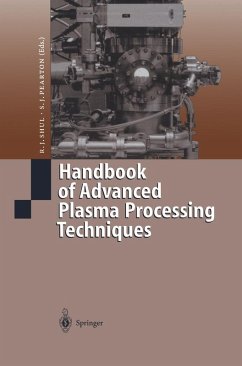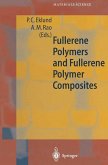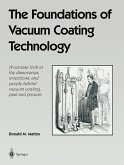Handbook of Advanced Plasma Processing Techniques (eBook, PDF)
Redaktion: Shul, R. J.; Pearton, S. J.
296,95 €
296,95 €
inkl. MwSt.
Sofort per Download lieferbar

148 °P sammeln
296,95 €
Als Download kaufen

296,95 €
inkl. MwSt.
Sofort per Download lieferbar

148 °P sammeln
Jetzt verschenken
Alle Infos zum eBook verschenken
296,95 €
inkl. MwSt.
Sofort per Download lieferbar
Alle Infos zum eBook verschenken

148 °P sammeln
Handbook of Advanced Plasma Processing Techniques (eBook, PDF)
Redaktion: Shul, R. J.; Pearton, S. J.
- Format: PDF
- Merkliste
- Auf die Merkliste
- Bewerten Bewerten
- Teilen
- Produkt teilen
- Produkterinnerung
- Produkterinnerung

Bitte loggen Sie sich zunächst in Ihr Kundenkonto ein oder registrieren Sie sich bei
bücher.de, um das eBook-Abo tolino select nutzen zu können.
Hier können Sie sich einloggen
Hier können Sie sich einloggen
Sie sind bereits eingeloggt. Klicken Sie auf 2. tolino select Abo, um fortzufahren.

Bitte loggen Sie sich zunächst in Ihr Kundenkonto ein oder registrieren Sie sich bei bücher.de, um das eBook-Abo tolino select nutzen zu können.
The ability to make small features in Si, metals, dielectrics and other materials is what has enabled rapid advances in computing, communications, aeronautics and all other technologies that depend on microelectronics, miniature sensors and actuators and magnetic data storage. Plasma techniques enable the fine control and accurate pattern transfer and thus are central to our technology age.
- Geräte: PC
- ohne Kopierschutz
- eBook Hilfe
- Größe: 66MB
Andere Kunden interessierten sich auch für
![Fundamental Electron Interactions with Plasma Processing Gases (eBook, PDF) Fundamental Electron Interactions with Plasma Processing Gases (eBook, PDF)]() Loucas G. ChristophorouFundamental Electron Interactions with Plasma Processing Gases (eBook, PDF)160,95 €
Loucas G. ChristophorouFundamental Electron Interactions with Plasma Processing Gases (eBook, PDF)160,95 €![Fullerene Polymers and Fullerene Polymer Composites (eBook, PDF) Fullerene Polymers and Fullerene Polymer Composites (eBook, PDF)]() Fullerene Polymers and Fullerene Polymer Composites (eBook, PDF)72,95 €
Fullerene Polymers and Fullerene Polymer Composites (eBook, PDF)72,95 €![Handbook of Theoretical Atomic Physics (eBook, PDF) Handbook of Theoretical Atomic Physics (eBook, PDF)]() Miron AmusiaHandbook of Theoretical Atomic Physics (eBook, PDF)160,95 €
Miron AmusiaHandbook of Theoretical Atomic Physics (eBook, PDF)160,95 €![Plasma Physics (eBook, PDF) Plasma Physics (eBook, PDF)]() K. NishikawaPlasma Physics (eBook, PDF)112,95 €
K. NishikawaPlasma Physics (eBook, PDF)112,95 €![The Foundations of Vacuum Coating Technology (eBook, PDF) The Foundations of Vacuum Coating Technology (eBook, PDF)]() Donald M. MattoxThe Foundations of Vacuum Coating Technology (eBook, PDF)40,95 €
Donald M. MattoxThe Foundations of Vacuum Coating Technology (eBook, PDF)40,95 €![Theoretical Surface Science (eBook, PDF) Theoretical Surface Science (eBook, PDF)]() Axel GroßTheoretical Surface Science (eBook, PDF)59,95 €
Axel GroßTheoretical Surface Science (eBook, PDF)59,95 €![Plasma Physics for Controlled Fusion (eBook, PDF) Plasma Physics for Controlled Fusion (eBook, PDF)]() Kenro MiyamotoPlasma Physics for Controlled Fusion (eBook, PDF)112,95 €
Kenro MiyamotoPlasma Physics for Controlled Fusion (eBook, PDF)112,95 €-
-
-
The ability to make small features in Si, metals, dielectrics and other materials is what has enabled rapid advances in computing, communications, aeronautics and all other technologies that depend on microelectronics, miniature sensors and actuators and magnetic data storage. Plasma techniques enable the fine control and accurate pattern transfer and thus are central to our technology age.
Dieser Download kann aus rechtlichen Gründen nur mit Rechnungsadresse in A, B, BG, CY, CZ, D, DK, EW, E, FIN, F, GR, HR, H, IRL, I, LT, L, LR, M, NL, PL, P, R, S, SLO, SK ausgeliefert werden.
Produktdetails
- Produktdetails
- Verlag: Springer Berlin Heidelberg
- Seitenzahl: 655
- Erscheinungstermin: 28. Juni 2011
- Englisch
- ISBN-13: 9783642569890
- Artikelnr.: 53317206
- Verlag: Springer Berlin Heidelberg
- Seitenzahl: 655
- Erscheinungstermin: 28. Juni 2011
- Englisch
- ISBN-13: 9783642569890
- Artikelnr.: 53317206
- Herstellerkennzeichnung Die Herstellerinformationen sind derzeit nicht verfügbar.
The ability to make small features in Si, metals, dielectrics and other materials is what has enabled rapid advances in computing, communications, aeronautics and all other technologies that depend on microelectronics, miniature sensors and actuators and magnetic data storage. Plasma techniques enable the fine control and accurate pattern transfer and thus are central to our technology age.
1 Some Fundamental Aspects of Plasma-Assisted Etching.- 1.1 Introduction.- 1.2 The Evolution of Plasma Etching Equipment.- 1.3 The Role of Ions in Reactive Ion Etching.- 1.4 The Influence of the Reactor Walls and Other Surfaces.- 1.5 Ion Beam-Based Methods.- 1.6 Summary.- References.- 2 Plasma Fundamentals for Materials Processing.- 2.1 Introduction.- 2.2 Single Particle Motion.- 2.3 Collision Processes.- 2.4 Velocity Distributions.- 2.5 Sheaths.- 2.6 Plasma Transport.- 2.7 Dielectric Properties.- 2.8 Plasma Sources for Thin Films Processing.- References.- 3 Plasma Modeling.- 3.1 Introduction.- 3.2 Historical Perspective.- 3.3 Plasma Modeling Issues.- 3.4 Chemical Reaction Mechanisms.- 3.5 Examples of Application of Plasma Modeling to Design or Optimization.- 3.6 Future Directions of Plasma Modeling.- References.- 4 Plasma Reactor Modeling.- 4.1 Introduction.- 4.2 Reactor Scale Model.- 4.3 Feature Level Modeling.- 4.4 Database Needs.- 4.5 Concluding Remarks.- References.- 5 Overview of Plasma Diagnostic Techniques.- 5.1 Introduction.- 5.2 Plasma Electrical Characterization.- 5.3 Optical Diagnostic Techniques.- References.- 6 Mass Spectrometric Characterization of Plasma Etching Processes.- 6.1 Introduction.- 6.2 Application to Fundamental Studies.- 6.3 Application in Etch Processing Reactors.- 6.4 Summary and Future Directions.- References.- 7 Fundamentals of Plasma Process-Induced Charging and Damage.- 7.1 Introduction.- 7.2 The Origin of Pattern-Dependent Charging.- 7.3 The Notching Effect.- 7.4 Other Profile Effects Influenced by Charging.- 7.5 Gate Oxide Degradation.- 7.6 Charging Reduction Methodology.- 7.7 Concluding Remarks.- References.- 8 Surface Damage Induced by Dry Etching.- 8.1 Introduction.- 8.2 Surface Damage in Si.- 8.3 Surface Damage in III-V Semiconductors.- 8.4 Damage Removal.- 8.5 Summary.- References.- 9 Photomask Etching.- 9.1 Introduction.- 9.2 Optical Lithography.- 9.3 X-Ray Lithography.- 9.4 SCALPEL.- 9.5 EUVL.- 9.6 Ion Projection Lithography.- 9.7 IPL Mask Distortion Issues.- 9.8 Conclusion.- References.- 10 Bulk Si Micromachining for Integrated Microsystems and MEMS Processing.- 10.1 Introduction.- 10.2 Etch Technologies.- 10.3 ECR Results.- 10.4 DRIE Results.- 10.5 DRIE Applications.- 10.6 Conclusions.- References.- 11 Plasma Processing of III-V Materials.- 11.1 Introduction.- 11.2 Dry Etching Techniques.- 11.3 Masking Materials and Methods.- 11.4 Dry Etching Chemistries.- 11.5 Dry Etching of GaAs and Related Materials.- 11.6 Dry Etching of InP and Related Materials.- 11.7 Dry Etching of GaN and Related Materials.- 11.8 Selective Dry Etching of III-V Materials.- 11.9 Conclusion.- References.- 12 Ion Beam Etching of Compound Semiconductors.- 12.1 Introduction.- 12.2 Definitions.- 12.3 Ion Sources.- 12.4 Historic Development.- 12.5 Grid Design, Beam Uniformity, and Divergence.- 12.6 Brief Overview of Etching Kinetics and Chemistry.- 12.7 Surface Quality and Etch Masking.- 12.8 RIBE Etch Technology.- 12.9 CAIBE Etch Technology.- 12.10 Endpoint Detection.- 12.11 Damage.- References.- 13 Dry Etching of InP Vias.- 13.1 Introduction.- 13.2 Past Difficulties in Obtaining High Rate Etching for InP.- 13.3 High Density Plasma Sources for High InP Etch Rate.- 13.4 Measurement of Plasma Heating for InP Etching.- 13.5 Application to Via Hole Etching.- 13.6 Summary.- References.- 14 Device Damage During Low Temperature High-Density Plasma Chemical Vapor Deposition.- 14.1 Introduction.- 14.2 Experimental.- 14.3 Results and Discussion.- 14.4 Summary and Conclusions.- References.- 15 Dry Etching of Magnetic Materials.- 15.1Introduction.- 15.2 Ion Milling.- 15.3 Cl2-Based ICP Etching of NiFe and Related Materials.- 15.4 Copper Dry Etching in Cl2/Ar.- 15.5 CO/NH3 Etching of Magnetic Materials.- 15.6 ECR and ICP Etching of NiMnSb.- 15.7 Dry Etching of LaCaMnOx and SmCo.- 15.8 Summary and Conclusions.- References.
1 Some Fundamental Aspects of Plasma-Assisted Etching.- 1.1 Introduction.- 1.2 The Evolution of Plasma Etching Equipment.- 1.3 The Role of Ions in Reactive Ion Etching.- 1.4 The Influence of the Reactor Walls and Other Surfaces.- 1.5 Ion Beam-Based Methods.- 1.6 Summary.- References.- 2 Plasma Fundamentals for Materials Processing.- 2.1 Introduction.- 2.2 Single Particle Motion.- 2.3 Collision Processes.- 2.4 Velocity Distributions.- 2.5 Sheaths.- 2.6 Plasma Transport.- 2.7 Dielectric Properties.- 2.8 Plasma Sources for Thin Films Processing.- References.- 3 Plasma Modeling.- 3.1 Introduction.- 3.2 Historical Perspective.- 3.3 Plasma Modeling Issues.- 3.4 Chemical Reaction Mechanisms.- 3.5 Examples of Application of Plasma Modeling to Design or Optimization.- 3.6 Future Directions of Plasma Modeling.- References.- 4 Plasma Reactor Modeling.- 4.1 Introduction.- 4.2 Reactor Scale Model.- 4.3 Feature Level Modeling.- 4.4 Database Needs.- 4.5 Concluding Remarks.- References.- 5 Overview of Plasma Diagnostic Techniques.- 5.1 Introduction.- 5.2 Plasma Electrical Characterization.- 5.3 Optical Diagnostic Techniques.- References.- 6 Mass Spectrometric Characterization of Plasma Etching Processes.- 6.1 Introduction.- 6.2 Application to Fundamental Studies.- 6.3 Application in Etch Processing Reactors.- 6.4 Summary and Future Directions.- References.- 7 Fundamentals of Plasma Process-Induced Charging and Damage.- 7.1 Introduction.- 7.2 The Origin of Pattern-Dependent Charging.- 7.3 The Notching Effect.- 7.4 Other Profile Effects Influenced by Charging.- 7.5 Gate Oxide Degradation.- 7.6 Charging Reduction Methodology.- 7.7 Concluding Remarks.- References.- 8 Surface Damage Induced by Dry Etching.- 8.1 Introduction.- 8.2 Surface Damage in Si.- 8.3 Surface Damage in III-V Semiconductors.- 8.4 Damage Removal.- 8.5 Summary.- References.- 9 Photomask Etching.- 9.1 Introduction.- 9.2 Optical Lithography.- 9.3 X-Ray Lithography.- 9.4 SCALPEL.- 9.5 EUVL.- 9.6 Ion Projection Lithography.- 9.7 IPL Mask Distortion Issues.- 9.8 Conclusion.- References.- 10 Bulk Si Micromachining for Integrated Microsystems and MEMS Processing.- 10.1 Introduction.- 10.2 Etch Technologies.- 10.3 ECR Results.- 10.4 DRIE Results.- 10.5 DRIE Applications.- 10.6 Conclusions.- References.- 11 Plasma Processing of III-V Materials.- 11.1 Introduction.- 11.2 Dry Etching Techniques.- 11.3 Masking Materials and Methods.- 11.4 Dry Etching Chemistries.- 11.5 Dry Etching of GaAs and Related Materials.- 11.6 Dry Etching of InP and Related Materials.- 11.7 Dry Etching of GaN and Related Materials.- 11.8 Selective Dry Etching of III-V Materials.- 11.9 Conclusion.- References.- 12 Ion Beam Etching of Compound Semiconductors.- 12.1 Introduction.- 12.2 Definitions.- 12.3 Ion Sources.- 12.4 Historic Development.- 12.5 Grid Design, Beam Uniformity, and Divergence.- 12.6 Brief Overview of Etching Kinetics and Chemistry.- 12.7 Surface Quality and Etch Masking.- 12.8 RIBE Etch Technology.- 12.9 CAIBE Etch Technology.- 12.10 Endpoint Detection.- 12.11 Damage.- References.- 13 Dry Etching of InP Vias.- 13.1 Introduction.- 13.2 Past Difficulties in Obtaining High Rate Etching for InP.- 13.3 High Density Plasma Sources for High InP Etch Rate.- 13.4 Measurement of Plasma Heating for InP Etching.- 13.5 Application to Via Hole Etching.- 13.6 Summary.- References.- 14 Device Damage During Low Temperature High-Density Plasma Chemical Vapor Deposition.- 14.1 Introduction.- 14.2 Experimental.- 14.3 Results and Discussion.- 14.4 Summary and Conclusions.- References.- 15 Dry Etching of Magnetic Materials.- 15.1Introduction.- 15.2 Ion Milling.- 15.3 Cl2-Based ICP Etching of NiFe and Related Materials.- 15.4 Copper Dry Etching in Cl2/Ar.- 15.5 CO/NH3 Etching of Magnetic Materials.- 15.6 ECR and ICP Etching of NiMnSb.- 15.7 Dry Etching of LaCaMnOx and SmCo.- 15.8 Summary and Conclusions.- References.







